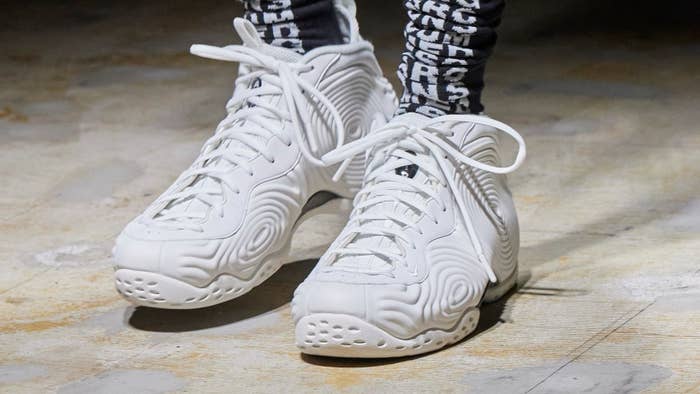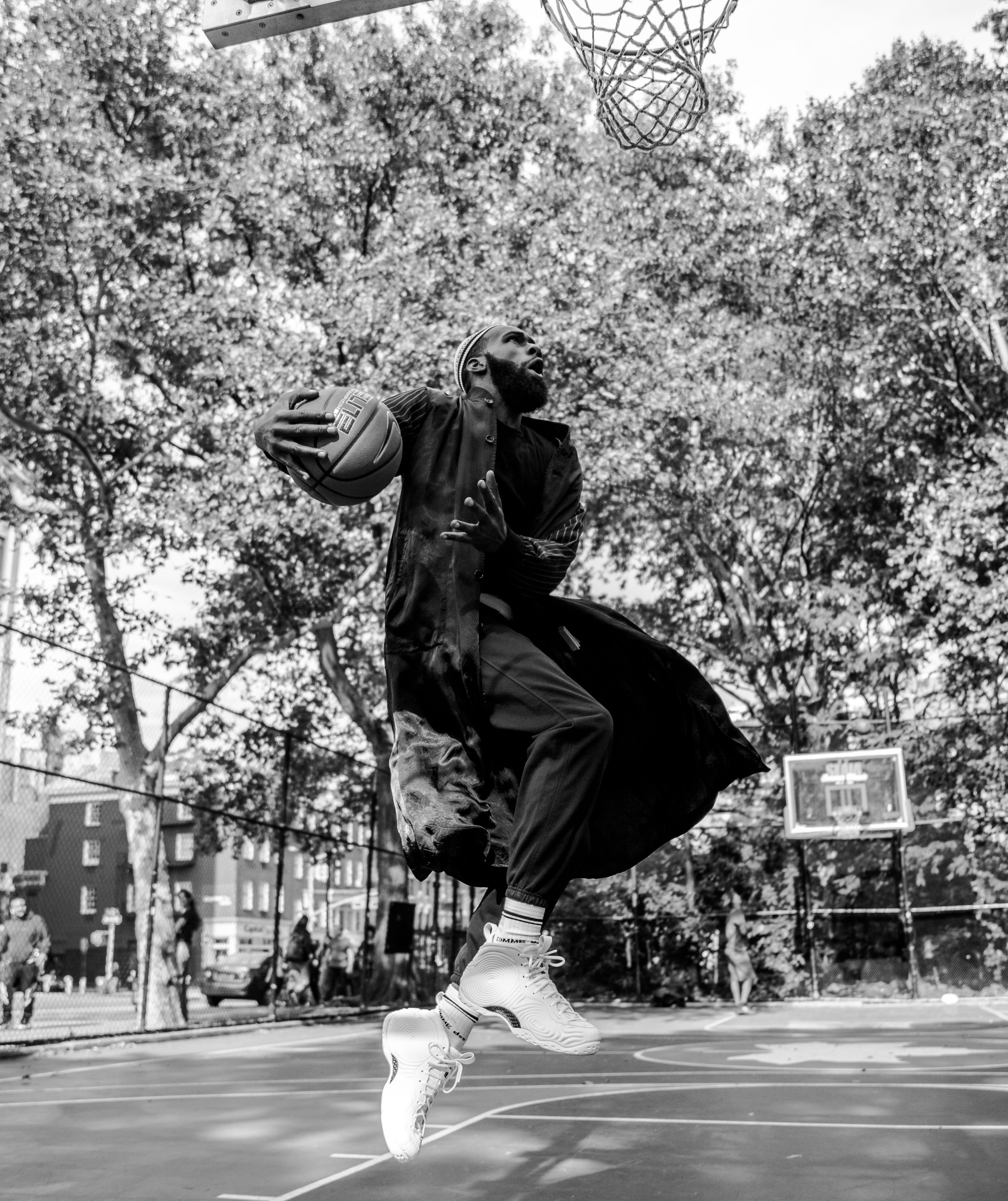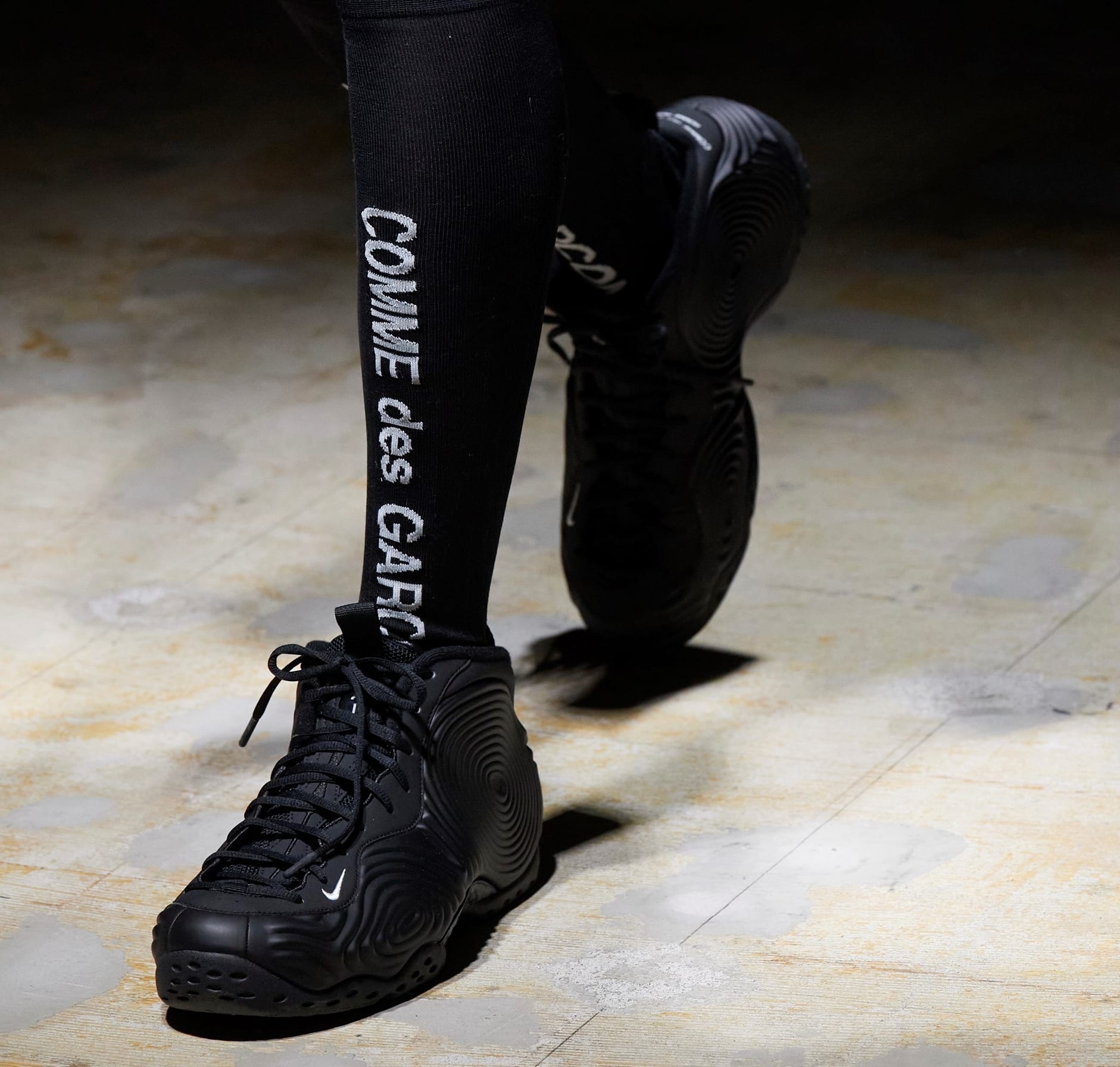
ASAP Nast still recalls his first pair of Comme des Garçons Nikes, but the memory is all he has. The physical sneakers, a version of the Air Kukini from the early 2000s designed by Comme-affiliated designer Junya Watanabe, crumbled underneath his feet on a sidewalk years ago.
“I was walking down the block and I remember looking back and the sole of the shoe was behind me,” the rapper says.
His deep appreciation for Comme des Garçons, the Japanese fashion label started by Rei Kawakubo in 1969, stretches back to 2004. The young Nast was seeing Comme gear in Japanese magazines and started to strategize on how he could get its clothes and shoes in his native New York. He inherited the Kukinis from a friend, not considering the care the vintage pair would need to survive real wear. Although those are gone, he’s continued to collect shoes from the Comme des Garçons x Nike catalog, a deep, long-running partnership that will grow next week with the release of two Air Foamposite Ones that reshape the shoe’s molded upper.
The Comme des Garçons x Nike Air Foamposite One will launch exclusively at the brand’s stores and Dover Street Market locations globally on Nov. 5. That debut will be followed by a wider release at Comme des Garçons’ wholesale clients. The shoes, priced at $520 each, will not release directly via Nike, according to CDG. They will be sold in men’s sizes 5 from 13 and women’s sizes from 6.5 to 14.5. They come in two straightforward colorways of black and white, both marked with the label’s name on the heel and featuring an upper looking something like a radiating sonar wave or a fingerprint.
Comme des Garçons introduced the shoes this week with a campaign shot by photographer Anthony Geathers and featuring NYC basketball player JayWill. The Foamposite collab is representative of how far the silhouette, a shoe that debuted in 1997 as a real performance model, has traveled culturally in its retro life.

Bajun Riddick, the store director at Comme des Garcons Chelsea in New York, remembers the sneakers being far from a fashion item for most of the people who he saw with them in the city in the 1990s. He wasn’t wearing the Foams, his wardrobe consisting instead of Prada Sport and Air Max 97s. To him, the model was for two very specific customers.
“You were either a serious baller or you were a serious drug dealer. I mean, no one else was running around with Foams around me,” Riddick says. “And even the kids who were serious ballers never wore them in the street.”
Nast says he and his brother had them growing up, but agrees that back then the Foamposite was very much a basketball shoe. It was aggressively weird, looking like a sentient blob waving up the wearer’s foot. In Harlem, the sneaker was most prevalent on the court and in the streets people walked going to and from the court.
“I didn’t really see too many people wearing them on a style tip,” he says.
This had to do partly with the price. The Nike Air Foamposite One and the related Air Foamposite Pro, with the big Swoosh across its side, have always been expensive sneakers. That’s because of their costly production: Nike spent $750,000 opening up a mold to make the shoes. If someone was paying the price—$180 on their original release—that generally meant they wanted them to do more than look good.
Nast and Riddick, who met around 2007, believe that if there was a discrete moment when the Foamposite One shifted into more of a style shoe, it came as the sneakers were retroed in the late 2000s. In the first half of the decade, Nike extended the life of the Foamposite Pro with new colorways. Starting in 2007 it brought back the Foamposite One, cementing the alien-looking shoe as a retro success. From there Nike turned on the turbo, regularly cranking out new colorways and later adding prints to the shoe, as on the landmark “Galaxy” pair from 2012.

For all the changes made to the shoes in the past decade, those applied by Comme des Garçons are still novel. The collaboration marks the first time Nike has significantly altered the upper of the shoe rather than just printing on top of it. This is not uncommon in its work with Comme des Garçons, which often takes the form of raw detailing, as on its Air Max 95s, or ostentatious additions, as on its Air Force 1s wearing plastic dinosaur molds. The Foamposite is a different kind of canvas.
“No one would ever expect her to go for a basketball shoe like that one,” Nast says of CDG founder Kawakubo. “She’s done basketball shoes before, but this one in particular was kinda like, ‘Whoah, Foamposites?’”
He figured it was a deep fake at first, a concept shoe that you might see floating around on Instagram. The basketball sneakers CDG has worked on tend to be much older, less techy, and more mainstream.
Riddick did a double-take when Foam collaboration first appeared in Tokyo in January 2021 at the Comme des Garçons Homme Plus Fall/Winter 2021 show, wondering if he was seeing what he thought he was. He’d had a similar reaction to the Comme des Garçons x Air Jordan 1s that outfitted that iconic retro with a chunky buckle, or the camouflage women’s Dunks. This felt like a step further.

“Knowing how much goes into making a Foamposite and the molds and actually seeing a different mold being used—they created a mold for us,” he says.
In his capacity managing a Comme store in New York, Riddick sees sees the reception to the sneakers firsthand. The crowds that come are comprised of more than just sneakerheads. There are kids eagerly seeking out whatever hype product is available to them, but there are also longtime collectors who are there to add the shoes to their personal archives of the brand.
Nast is somewhere between—maybe right in the middle of—these crowds. He is serious about Comme des Garçons, mentioning in conversation the many items from the brand that surround him. It’s an important brand to him, a man who is proud of his personal style and serious about fashion. But he also has a sneakerhead’s craving to be early.
“I care about being the first person with Comme anything,” he says.
He’s not a traditionalist when it comes to sneakers, not irked when shoes are changed by outside entities as drastically as these Foams are. He has spent time in the industry, though, working at the Harlem outpost of Japan-based sneaker boutique Atmos in his youth. Before the ASAP Mob rushed the rap industry in the 2010s, he formed crucial relationships there. He met Nipsey Hussle, Mos Def, and Dave Chappelle while working at Atmos. Teyana Taylor worked at the store as well.
“It’s a major part of my history,” he says, “me meeting some of the cool people that I’ve met that connected the dots to get me to where I am now.”
With the responsibility of working the store came an illusion of power. While Nast worked at Atmos, he’d have people coming to him to cash in sneaker favors, which he usually couldn’t help with.
“If you had the plug, you had the plug,” he says. “I wouldn’t necessarily say I was the plug for any of them. People definitely thought I was.”
Similar expectations fall on Riddick, a keeper of Comme at his Chelsea store. The approach to releasing them there isn’t the same as at a straightforward sneaker store, tailored instead to fit the unique clientele. There, the limited-edition Foams exist in a different context, far from their original role as a sport shoe and distanced a bit from their recent status as a hype shoe. They are there for the young crowd, but also for their 60-year-old parents who own Off-White Jordans.
For a Nike drop, Riddick and his staff want to make people as aware as possible. They’ll take down names for customers who want to buy pairs. The day of release is hectic, especially for those unfamiliar with the chase, but the plan isn’t to clear out the stock as quick as possible. The rollout is something more considered than the militant setting demanded at some sneaker stores.
“I always make sure that if you’re there that day, you probably will walk away with something,” Riddick says.

